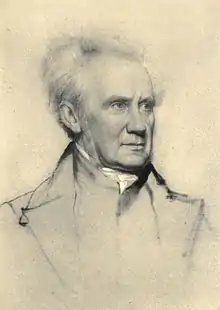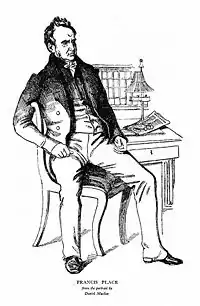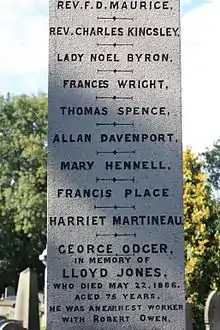Francis Place
Francis Place (3 November 1771 in London – 1 January 1854 in London) was an English social reformer.

Early life
He was an illegitimate son of Simon Place and Mary Gray. His father was originally a journeyman baker. He then became a Marshalsea Court officer and ran a sponging-house in Vinegar Yard, Brydges Street, opposite the south side of the Theatre Royal, Drury Lane; Brydges Street is now named Catherine Street.[1] Francis Place was born there on 3 November 1771, and baptised at St Martin-in-the-Fields, on 1 December 1771.[2] His older sister, Hannah, had been born there on 17 April 1770.[3] Not long after he was born, Francis, his parents, and older sister, moved to a house in Ship and Anchor Court, near Temple Bar, London. His younger brother named George, was born there in August 1773 and a younger sister Ann was born there in June 1775.[4] In June 1780, Simon Place became a publican and moved his family to the Kings Arms, in Arundel Street, in the Strand.
Francis was schooled until 1785. On 20 June 1785, he was apprenticed to Joseph France, a leather-breeches maker in Temple Bar.[5][6]
Father involved in a suit
In Place's autobiography, he stated that his mother's maiden surname was Gray. But he did not know where his parents had met, or when they married. From his mother's recollection to Francis, he was told that she had married Simon at aged 25, which Place presumed was in 1755 or 1756.[7] But no record appears to have been found of a marriage between the couple.
At around the time that Francis Place was apprenticed, his father was involved in a suit in the ecclesiastical court in the parish of St Clement Danes: A lady named Anna Place, had come to the Overseers and claimed parish aid, as the wife of Simon Place of Arundel Street. She had a daughter named Mary, who was then the wife of Henry Kitchin of Clerkenwell.[8] The Parish Officers advised Simon to make a small weekly allowance for Anna, because they did not want the matter to become public. But Simon refused, saying he would have nothing to do with her, and that Anna was not and never had been, his wife. And so an action commenced in the ecclesiastical court. Anna claimed that she was the wife of Simon from a Fleet marriage which had occurred around forty years prior to this. This case lasted for around three years, according to Place's autobiography. It resulted in his father losing the case, and cost Simon several hundreds of pounds to defend himself.[9] Simon Place (with his surname written as "Plaise" in the original register) had married Anna Peters at Fleet Prison, on 29 October 1747.[10] This was only four days after Mary Place, daughter of Simon, was baptised at St Anne's Church, Soho.[11] Mary Place married Henry Kitchin at St Pancras Old Church, on 30 January 1768.[12]
Career
At eighteen, Place was an independent journeyman. On 7 March 1791, he was married to Elizabeth Chad at St Mary's Church, Lambeth.[13][14] At the time of marriage, Francis was nineteen years old, and his bride was three weeks short of her seventeenth birthday.[15] They moved to a house near the Strand.
In 1793 he became involved in and eventually the leader of a strike of leather-breeches makers, and was refused work for several years by London's master tailors; he exploited this time by reading avidly and widely. In 1794, Place joined the London Corresponding Society, a reform club, and for three years was prominent in its work, before resigning his post as chairman of the general committee in 1797 in protest at the violent tactics and rhetoric of some group members. In 1799 he became the partner in a tailor's shop, and a year later set up his own successful business at 16 Charing Cross.
Energetic Radical

Withdrawing from politics whilst he established his business, he devoted three hours an evening after work to studying, eventually establishing such a large personal library in the back of his shop that it soon became a meeting place for radicals. In 1807 he supported Sir Francis Burdett, 5th Baronet, a Parliamentary candidate for Westminster, which allowed him to come into contact with such theorists as William Godwin, James Mill, Robert Owen, Jeremy Bentham, Joseph Hume and John Stuart Mill. When Place retired in 1817 (with a steady stream of income from his shop, now run by his children), he lived for several months with Bentham and the Mills at Forde Abbey.
It was around this time that he became involved in the movement for organised, public education, believing it to be a means of eradicating the ills of the working class. In the early 1820s he also became a Malthusian, believing that as the population increased it would outstrip the food supply. He successfully associated Malthus with the idea of birth control (which Malthus himself had opposed despite his fears of overpopulation). Despite himself having fathered fifteen children, he advocated the use of contraception, although was not specific about in what forms. It was on this topic that he wrote his only published book, the influential and controversial Illustrations and Proofs of the Principles of Population, in 1822.[16][17]
Place also lobbied successfully for the 1824 repeal of the Combination Act, which helped early Trade Unionism, though new restrictions were soon introduced. Place himself regarded trade unionism as a delusion that workers would soon forget about if they were allowed to try it.[16]

In 1827 he entered a long period of depression after the death of his wife from cancer. On 13 February 1830, in Kensington, he married Louisa Chatterley, a London actress.[18][14] Also in this year, Place helped support Rowland Detrosier, a working class radical activist who also sought to distance himself from socialism.[19] Through Place, Detrosier would be introduced to figures such as Bentham and J.S. Mill, who in turn introduced him to Thomas Carlyle. Detrosier's activities and writings would be influential amongst Manchester Radicals and the later Chartists. He was also active in the agitation that led to the Reform Act of 1832, holding up the recent revolution in Paris as an example of what could happen if reform wasn't allowed by legal means.
Moral-force Chartist and old age
Having lost much of his money in 1833 in bad investments, Place had to move from Charing Cross to Brompton Square,[14] and lost his regular contact with the Reformist middle-class. However, he remained politically active, working against the stamp tax and involving himself in the London Working Men's Association, within which in 1838 he and William Lovett drafted the document that would become the People's Charter. It then became evident that many Chartists were willing to use violent means, and when Feargus O'Connor replaced Lovett as the effective leader of the movement, Place ceased to be involved in Chartist activities.[16] On rescinding his involvement with the Chartists, he became involved in the movement to repeal the Corn Laws.
For the next two decades he wrote his autobiography and organised the immense collection he had made: notes, pamphlets, newspapers and letters. He separated from his wife in 1851. Francis then went to live in Hammersmith for two years with his daughter Annie, the wife of John Miers, and their family. He then brought a house at 6, Foxley Terrace, Earls Court, Kensington, and lived there with his two unmarried daughters, Mary and Jane.[20] Francis Place died at this address on the morning of 1 January 1854.[21] He was buried on 7 January 1854, at Brompton Cemetery.[22]
Memorials

Place is listed on the Reformers' Memorial in Kensal Green Cemetery in London.
Legacy
His pamphlets, letters, magazine and newspaper articles throw light on the social and economic history of the nineteenth century.[23] His hoarding of documents create an important archive. The British Library currently holds these documents in fifty-four reels of micro-film as the Francis Place Collection.[24]
See also
Notes
- "Bow Street and Russell Street Area: Catherine Street." in Survey of London: Volume 36, Covent Garden, ed. F H W Sheppard (London, 1970), p. 199. British History Online. Retrieved 13 November 2020.
- "Westminster, London, England, Church of England Baptisms, Marriages and Burials, 1558-1812 for Francis Place." St Martin-in-The-Fields: 1763 - 1775.City of Westminster Archives Centre; London, England; Westminster Church of England Parish Registers; Reference: SMTF/PR/2/5. Ancestry.com, 2020. Retrieved 12 November 2020.
- "Westminster, London, England, Church of England Baptisms, Marriages and Burials, 1558-1812 for Hannah Place." St Martin-in-The-Fields: 1763 - 1775.City of Westminster Archives Centre; London, England; Westminster Church of England Parish Registers; Reference: SMTF/PR/2/5. Ancestry.com, 2020. Retrieved 13 November 2020.
- "Chapter 2. Parents' married life to June 1780." The Autobiography of Francis Place (1771 - 1854). Mary Thale, 1972. Cambridge University Press, 2008; Reprint edition (18 August 2010). p. 25. Retrieved 13 November 2020.
- Thomas, William. "Place, Francis". Oxford Dictionary of National Biography (online ed.). Oxford University Press. doi:10.1093/ref:odnb/22349. (Subscription or UK public library membership required.)
- "UK, Register of Duties Paid for Apprentices' Indentures, 1710-1811 for Francis Place." City (Town) Registers: 1783 Jun - 1786 Feb, p.173. The National Archives of the UK (TNA); Kew, Surrey, England; Collection: Board of Stamps: Apprenticeship Books: Series IR 1; Class: IR 1; Piece: 32. Ancestry.com. Retrieved 14 November 2020.
- "Chapter 1. Lineage." The Autobiography of Francis Place (1771 - 1854). Mary Thale, 1972. Cambridge University Press, 2008; Reprint edition (18 August 2010). p. 21. Retrieved 14 November 2020.
- "St Clement Danes, Alphabetical List of the House, 1785." London Lives, 1690-1800, WCCDLW360000113 (www.londonlives.org, version 2.0, March 2018), Westminster Archives Centre, Ms B1247, image 113 of 156. Retrieved 14 November 2020.
- "Chapter 5. Famiy History (1785 - 1789)." The Autobiography of Francis Place (1771 - 1854). Mary Thale, 1972. Cambridge University Press, 2008; Reprint edition (18 August 2010).p.85. Retrieved 14 November 2020.
- "London, England, Clandestine Marriage and Baptism Registers, 1667-1754 for Simon Plaise." Registers of Clandestine Marriages and of Baptisms in the Fleet Prison, King's Bench Prison, the Mint and the May Fair Chapel. Piece 237: Officiating Ministers: Symson, Tarrant, Crawford Deneveu, Dare. (1747 Jul - 1749 Dec), p.8. Ancestry.com 2013. Retrieved 14 November 2020.
- "Westminster, London, England, Church of England Baptisms, Marriages and Burials, 1558-1812 for Mary Place." St Anne, Soho: 1721 - 1767. City of Westminster Archives Centre; London, England; Westminster Church of England Parish Registers; Reference: SML/PR/3/11.Ancestry.com 2020.Retrieved 14 November 2020.
- "Mary Place in entry for Henry Kitchin, 30 Jan 1768, St Pancras Old Church, Saint Pancras, Middlesex, England." "England Marriages, 1538–1973 ", database, FamilySearch (https://familysearch.org/ark:/61903/1:1:NKPG-524 : 11 March 2020). Retrieved 14 November 2020.
- "London, England, Church of England Marriages and Banns, 1754-1932 for Francis Place." Lambeth: St Mary, Lambeth: Marriages 1785 - 1890, No.350, p.119.London Metropolitan Archives; London, England; Reference Number: p85/mry1/392. Ancestry.com, 2010. Retrieved 9 November 2020.
- "Francis Place". rbkc.gov.uk. Retrieved 10 July 2018.
- MAJOR EVENTS IN PLACE'S AUTOBIOGRAPHY: Editor's Introduction, p.39. The Autobiography of Francis Place (1771 - 1854). Mary Thale, 1972. Cambridge University Press, 2008; Reprint edition (18 August 2010). Retrieved 9 November 2020.
- "Francis Place". Spartacus Educational. Retrieved 11 August 2007.
- Stack, David (1998). Nature and Artifice. Boydell Press. pp. 29–30. ISBN 0861932293.
- "Francis Place - Louise Chatterley, 13 Feb 1830, Kensington." Greater London Marriage Index, Transcriptions © West Middlesex Family History Society: Findmypast. Retrieved 9 November 2020.
- Lee, M. (2004) "Detrosier, Rowland (1800?–1834)", Oxford Dictionary of National Biography, Oxford University Press, accessed 10 August 2007 (subscription required)
- The Autobiography of Francis Place (1771 - 1854). Mary Thale, 1972. Cambridge University Press, 2008; Reprint edition (18 August 2010).p.268. Retrieved 12 November 2020.
- "DEATHS." Saint James's Chronicle, 5 January 1854, p.4.The British Newspaper Archive: Findmypast Newspaper Archive Limited in partnership with the British Library. Retrieved 12 November 2020.
- "Brompton, London, England Cemetery Registers, 1840 - 2012 for Francis Place." The National Archives; Kew, London, England; Office of Works and successors: Royal Parks and Pleasure Gardens: Brompton Cemetery Records; Series Number: Work 97; Piece Number: 73. Ancestry.com, 2019. Retrieved 12 November 2020.
- Thomas (2006)
- http://www.bl.uk/reshelp/findhelprestype/microform/francisplace/index.html. Retrieved 19 March 2010
Bibliography
- Place, Francis [1822] Illustrations and Proofs of the Principles of Population, a new edition with introduction and critical and textual notes by Norman E. Himes, London, Geo. Allen and Unwin (1930)
- Thomas, W. (2006) "Place, Francis (1771–1854)", Oxford Dictionary of National Biography, Oxford University Press, online edn, accessed 11 Aug 2007 (subscription required)
- Wallas, Graham (September 2004). Life of Francis Place. Kessinger Publishing. ISBN 1-4179-4430-7.
- Miles, D. (1988) Francis Place: The life of a remarkable radical, Brighton UK, Harvester Press
External links
| Wikiquote has quotations related to: Francis Place |
- Wallas, Graham The life of Francis Place, 1771–1854, 1894, London, New York: Longmans, Green, from the Internet Archive
- Guide to Place, Francis. Papers, 1830–1832. 5421mf. Kheel Center for Labor-Management Documentation and Archives, Martin P. Catherwood Library, Cornell University.